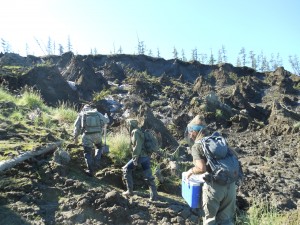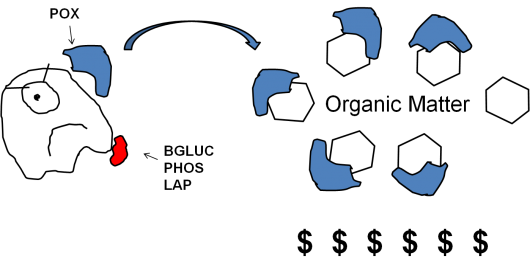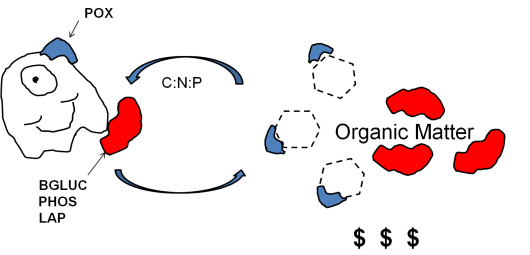Well as forecasted, the last few days of Polaris were some hectic ones…but I can happily say…MISSION ACCOMPLISHED!
As our data collecting was wrapping up, we were all working hard to simultaneously analyze our results, prepare our final presentations, and “cover our tracks”…so we can leave the NESS clean and organized, just like when we arrived.
As hectic as those days were, there is nothing like a pulse of adrenaline to go out with a bang! The 2013 Polaris Research Symposium was amazing, and it was rewarding to give my own final presentation and hear about all the phenomenal research conducted in the Y4 watershed. Now three flights across the world later and a week after I said goodbye to friends in Cherksiy and elsewhere, I’ve been relaxing at home with friends and family. However, I’m still on my toes and hard at work as the deadline for poster abstracts for the AGU (American Geophysical Union) Fall Meeting is fast approaching. The AGU meeting will give me an exciting chance to present my project results and conclusions at a national conference and reunite with Polaris members, so I’m eager to keep moving forward.
I’d like to switch the focus of this post and share with you my research project. As Karin mentioned previously, I’ve had the privilege to work side by side with her, Ludda, John, and Paul and I’m now looking forward to our efforts (hopefully) showing some cool results!
As global warming continues and inevitably increases permafrost thaw, it is important to better understand how the release of older and potentially more biologically available (biolabile) organic carbon (OC) will affect permafrost carbon feedbacks to climate change.
In addition, (and where the source of Karin and I’s question comes from) it is important to (1) identify high latitude areas that act as “hot-spots” for microbial activity and greenhouse gas emissions and (2) understand their potential for high responses to permafrost thaw. It has been well studied that stream waters act as hot-spots for activity; however, not much is known of the potential for stream bottoms. Karin and I believe that stream benthic sediments are likely a hot-spot for activity because they may serve as a converging point of organic matter (OM) draining from thawing permafrost from surrounding hill slopes. We believe that as the flow of water, and the quantity and quality of OM changes from greater permafrost thaw, stream benthic sediments may play a larger role in permafrost carbon feedbacks to climate change.

Hiking up the Duvannyi Yar outcrop to get some older, hopefully more biolabile organic matter.
Karin’s question revolves around the result (or consequence) of more biolabile OC entering stream benthic sediments (i.e. CO2 and CH4 emission rates). My question aims to determine the activity (or what’s causing the result) occurring within stream benthic sediments. To do this, I’ve measured the chemical compositions of older Duvannyi Yar soils and modern Y4 watershed soils, its OC biolability, and the enzyme activities when treating Y4 benthic sediments with these two sources of OM. I’m hoping to identify compositional characteristics of the older carbon (such as less structural complexity) that make it more biolabile (which can be measured by the rate that the carbon is consumed by microbes) and link these results with specific microbial enzyme activity rates.
So what’s all this talk about enzymes about? In the scope of my project, enzymes (which are protein-like biomolecules) are used as a tool for breaking down structural compounds in the organic matter that inhibit the microbe from obtaining the resources it needs to be active (and respire CO2 or CH4). When microbes are dealing with more complex structures surrounding their food (which is the case with less biolabile OC), they are forced to produce certain enzymes to first break down these complex structures and then produce other enzymes to extract the resources. I’m also aiming to identify which enzymes are being produced in stream benthic sediments…and their peak activities following exposure to more and less biolabile OC. Observing the enzyme activity rates can allow us to determine whether differences in greenhouse gas emissions are attributed to changes in microbial processing of (newly) thawed permafrost carbon or some other biological/ physical process.

A diagram depicting microbial enzyme activity associated with less biolabile organic matter. The one-eyed creature is the microbe, while POX are the structural breaking enzymes and the BGLUC, PHOS, and LAP are the resource extracting enzymes.

A diagram depicting microbial enzyme activity associated with more biolabile organic matter.
If this is all a bit confusing… think of yourself as a microbe, the utensils you use at the dinner table, as enzymes, and your food as organic matter. When you’re starving, lethargic, and ready to eat, you pick up your utensils and consume your food…now you’re energized and ready to go. Similar to a microbe, this is the most ideal situation to be in…but that’s not always the case. For example, sometimes you’re given soup, and so you use a spoon… it’s easier to sip…and you’re happy and active. Other times you’re given a far too cooked piece of meat…you’re forced to use a large knife to rip and tear apart your food before you can eat it…and this requires a lot more energy, and you may not get a lot out of it. In these cases, the soup represents more biolabile OC and so a happy active microbe produces resource extracting enzymes allowing it to respire more CO2 (diagram 2), while the far too cooked piece of meat represents the less biolabile OC, and your unhappy, less active microbe produces fewer resource extracting enzymes, consequently respiring less CO2 (diagram 1).
Cheers,
Craig



